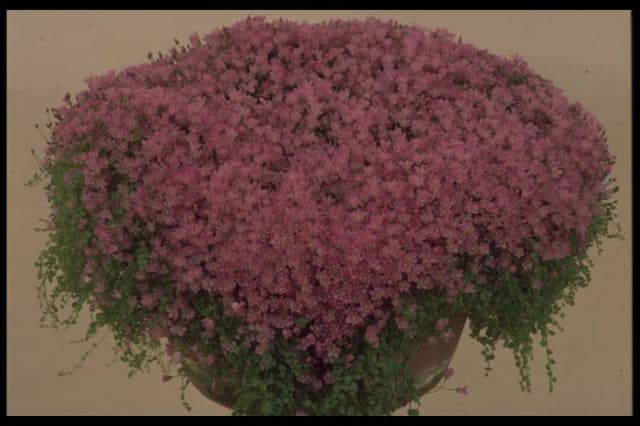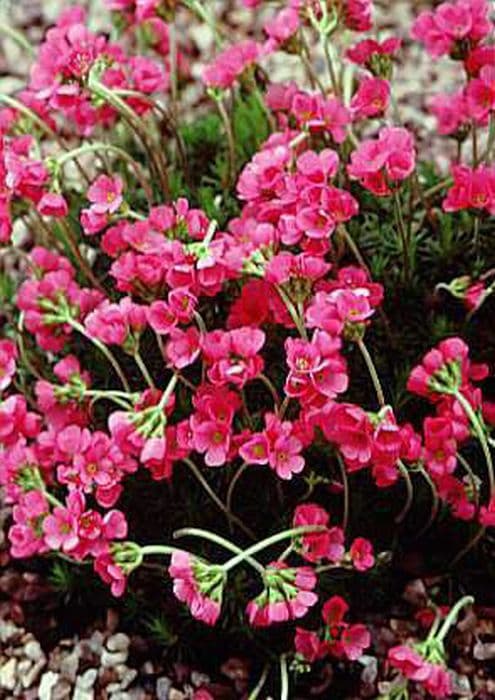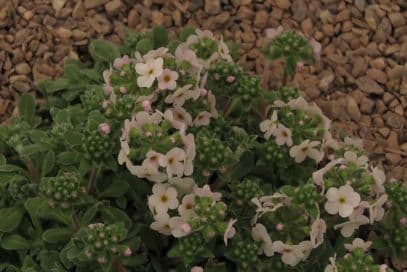Primrose 'Claddagh' Primula vulgaris 'Claddagh' (Pr/prim)

ABOUT
'Claddagh' is a semi-evergreen perennial forming a rosette of dark purple-bronze, wrinkled, oblong leaves. Golden-yellow flowers, with a slightly darker eye, are borne on short stems in spring
About this plant
 Names
NamesFamily
Primulaceae
Synonyms
Common Primrose, English Primrose, Claddagh Primrose
Common names
Primula vulgaris.
 Characteristics
CharacteristicsLife cycle
Perennials
Foliage type
Evergreen
Color of leaves
Green
Flower color
Yellow
Height
6 inches (15 cm)
Spread
8 inches (20 cm)
Plant type
Herb
Hardiness zones
5
Native area
Europe
Benefits
 General Benefits
General Benefits- Aesthetic Appeal: The Primula 'Claddagh' is known for its beautiful flowers which can enhance gardens and outdoor spaces.
- Easy to Grow: It is a hardy plant that can easily be cultivated in a variety of climate zones.
- Extended Blooming Period: It often has a long flowering period from late winter into spring.
- Attracts Wildlife: The flowers of the plant can attract pollinators such as bees and butterflies, encouraging biodiversity.
- Garden Structure: The rosettes of leaves provide low-growing structure to garden beds even when the plant is not in bloom.
- Edging and Border Planting: Its compact size makes it an ideal choice for edges, borders, and as ground cover.
- Color Variety: This cultivar may possess unique colors and patterns that can add variety to the garden palette.
- Shade Tolerance: Primula 'Claddagh' can tolerate semi-shade conditions, providing options for planting in less sunny spots.
- Drought Resistance: Once established, it can withstand periods of low water, although it prefers consistent moisture.
 Medical Properties
Medical Properties- Antitussive: May be used to soothe coughs.
- Expectorant: Has been utilized to aid in expelling phlegm from the respiratory tract.
- Anti-inflammatory: Contains compounds that could help reduce inflammation.
- Analgesic: It might offer some pain relief.
- Diuretic: Traditionally used to promote the flow of urine.
 Air-purifying Qualities
Air-purifying QualitiesThis plant is not specifically known for air purifying qualities.
 Other Uses
Other Uses- Crafting natural dyes: Primrose petals can be used to create a range of colors from pale yellow to green for dying fabrics or paper.
- Edible decorations: The flowers of the primrose can be crystallized with sugar and used as edible decorations on cakes and desserts.
- Garnishing dishes: Primrose flowers can add a touch of elegance as a garnish for salads and other cold dishes.
- Plant dye for Easter eggs: The natural dyes obtained from primrose can be used for coloring Easter eggs.
- Biodegradable confetti: Dried primrose petals are biodegradable and can serve as an eco-friendly alternative to traditional confetti.
- Educational tool: Primrose is a perfect example for teaching about native plant species and the importance of biodiversity in gardens.
- Photography subject: With its attractive form and colors, the primrose is a popular subject for photographers, particularly macro and nature photographers.
- Artistic inspiration: The unique appearance of the primrose often serves as an inspiration for botanical illustrators and artists.
- Cultural symbols: In various cultures, primroses are symbols of different values and are used in cultural festivals and art.
- Companion planting: Primroses can be planted alongside other shade-loving perennials in a woodland garden to create aesthetically pleasing and diverse plant compositions.
Interesting Facts
 Feng Shui
Feng ShuiThe English Primrose is not used in Feng Shui practice.
 Zodiac Sign Compitability
Zodiac Sign CompitabilityThe English Primrose is not used in astrology practice.
 Plant Symbolism
Plant Symbolism- Youthful Beauty: The like the primrose blooms early in spring, it is often associated with the freshness and beauty of youth.
- Hope: Since primroses are among the first flowers to bloom after the cold winter, they symbolize hope and the promise of times to come.
- Love and Affection: In the language of flowers, giving someone primroses can express a message of care and affection.
- Rarity: Due to their specific growing conditions and the short time they bloom, primroses can also represent rareness and uniqueness in a person or event.
- New Beginnings: Associated with the early spring, primroses are a symbol of new beginnings and the start of a new cycle.
 Water
WaterThe common primrose should be watered regularly to keep the soil moist but not waterlogged. During the growing season, it's best to water with about one inch of water per week. If the weather is particularly hot or dry, you may need to water more frequently. Ensure that water penetrates the soil to reach the roots rather than merely wetting the surface. It's crucial not to let the plant sit in water as this can lead to root rot.
 Light
LightCommon primrose thrives best in partial shade, avoiding the intense heat of the afternoon sun. An ideal spot for this plant is one that receives morning sunlight and is shaded in the afternoon. This dappled light mimics the woodland conditions that the common primrose is accustomed to in its natural habitat.
 Temperature
TemperatureCommon primrose prefers cooler temperatures and can survive in temperatures as low as 20°F but will not tolerate temperatures below freezing for extended periods. Ideally, they should be kept in an area where temperatures range between 50°F and 75°F. They are not suited for very hot climates and may not survive in temperatures above 80°F for prolonged periods.
 Pruning
PruningPruning common primrose helps to encourage a more robust plant by removing spent flowers and dead leaves. Prune lightly after the blooming period to promote a second flush of flowers. In general, trimming can be done as needed throughout the growing season to keep the plant tidy and healthy.
 Cleaning
CleaningAs needed
 Soil
SoilThe Common Primrose thrives in moist, humus-rich soil with good drainage. A soil mix with equal parts of garden loam, leaf mold/compost, and sand or perlite is ideal. Maintain soil pH between 6.0 and 7.0 for optimal growth.
 Repotting
RepottingCommon Primroses should be repotted every 1 to 2 years to replenish the soil and accommodate root growth. Younger, actively growing plants may require more frequent repotting.
 Humidity & Misting
Humidity & MistingPrimula vulgaris 'Claddagh' prefers high humidity levels; aim for 50-60% for optimal health.
 Suitable locations
Suitable locationsIndoor
Keep in bright, indirect light and maintain moist soil.
Outdoor
Plant in partial shade and keep soil consistently moist.
Hardiness zone
4-8 USDA
 Life cycle
Life cycleThe life of Primula vulgaris 'Claddagh', commonly known as the Claddagh Primrose, begins with seed germination, which typically occurs in spring, when soil temperatures warm and moisture is abundant. The seedlings develop into rosettes of oblong leaves, establishing a root system and foliage throughout the spring and summer. The plant may enter a dormant phase during the hot summer months or in colder climates, it may die back in winter to re-emerge in spring. In the second year and following years, the Claddagh Primrose produces stalks with whorls of flowers, usually in early spring, that are distinctive for their green-edged white petals and golden centers. After flowering, the plant sets seed, and these seeds disperse to begin new life cycles. The plant is perennial, so while individual flowers are short-lived, the rosette can persist and produce new flowers seasonally for several years.
 Propogation
PropogationPropogation time
Spring-Early Summer
The Primrose, specifically the Primula vulgaris 'Claddagh', can be propagated through division, which is the most popular method for this perennial plant. This is best done in late winter to early spring just before new growth begins. To propagate by division, carefully lift the plant from the ground with a garden fork, ensuring that you keep a good amount of soil attached to the roots. Gently tease apart the clumps into smaller sections, each with several leaves and a healthy root system. Replant the divisions immediately at the same depth they were growing at before, spacing them about 6 to 12 inches (15 to 30 centimeters) apart to allow ample room for growth. Water the new plants well to help establish them. This method of propagation is simple and helps to rejuvenate older plants by giving them more space to grow, while also increasing the number of plants in your garden.









